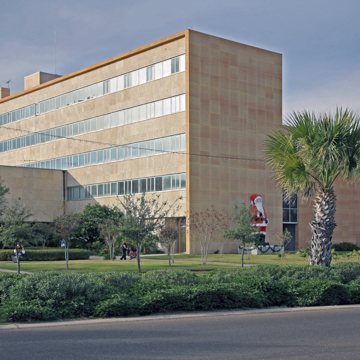In the original plat, a four-block area was set aside for a courthouse and public buildings where today U.S. 281 and FM 107 axially divide the city grid. The Hidalgo County Jail (1910) at 107 E. McIntyre Avenue is the only remnant of the original courthouse complex by Atlee B. Ayres and Henry T. Phelps of San Antonio. Serving today as a wing of the Museum of South Texas History, the white stucco, red-tile-roofed structure with corner tower was the counterpart to the imposing Mission Revival first Hidalgo County Courthouse (demolished), which was similar to Phelps's Atascosa County Courthouse ( CJ21).
The new, functional Hidalgo County Courthouse (1954) at 100 N. Closner Avenue, with exterior horizontal bands to express its multistory organization, was designed by R. Newell Waters and Merle Simpson, showing the former's transition from revivalist to modernist architect. In the vicinity of the courthouse at 300 W. Cano Avenue, the First Presbyterian Church (1953, 1960) is a steeply pitched geometric composition where Cocke, Bowman and York paid tribute to Frank Lloyd Wright and Eero Saarinen.


